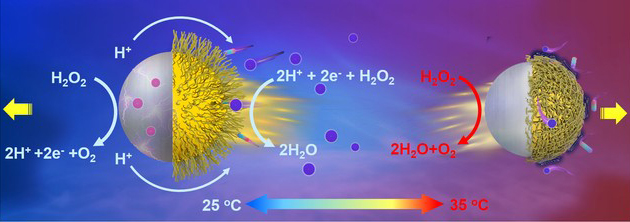Written by: Hua Wen
Translated by: Li Zebing
Edited by: William Mosteller
Date: 2019-4-12
Harbin Institute of Technology News (Hua Wen/Text) Supported by the National Natural Science Foundation of China (NSFC), Professor He Qiang from the Key Laboratory of Microsystems and Microstructure Manufacturing, Ministry of Education of China, made important progress in the field of colloidal motors. The research results were published in the internationally renowned journal German Applied Chemistry (Angew. Chem. Int. Ed., Influence Factor 12.102) under the title of "Thermotropic Polymer Brush Modulation on the Direction of Motion of Phoetically Driven Janus Micromotors". Professor He Qiang and Associate Professor Wu Yingjie of the School of Chemistry and Chemical Engineering are co-authors.
Colloidal motors convert the chemical energy stored in the surrounding environment into self-propelled moving colloidal particles (also known as active colloids or swimming micro-nanorobots). They can be used as a physical model to help people understand the self-organizing behavior of life systems, and can be used for biomimetic construction of active materials with emergent self-organizing and self-repairing characteristics. They are also expected to bring revolutionary solutions for biomedicine (especially precision medicine). At present, the movement speed of the chemically driven colloid motor mainly depends on artificial regulation of the fuel concentration, and the movement direction of the chemically driven colloid motor is realized through the manipulation of an external magnetic field; however, the chemically driven colloid motor cannot independently sense the change of the surrounding environment and independently regulate the movement direction and the movement speed as an organism, such as a swimming bacterium, would be able to.
In response to this challenge, the team for the first time in situ grew thermosensitive polyisopropylacrylamide (PNIPAM) polymer brushes on the gold side of gold-platinum bimetallic anode-cation motors. When the temperature is 25 ℃, the polymer brush chain on the gold surface is in the extended and hydrophilic state, which allows the free diffusion of the substance in the polymer brush, as well as surface reaction. The colloidal motor moves along the Au-Pt direction at the rate of 8.5 μ m/s, and the driving mechanism is self-electrophoresis. When the temperature rises to 35 ℃, the polymer brush chain collapses and gets hydrophobic, and the motor moves along the Pt-Au direction at a speed of 2.3 μ m/s. The driving mechanism is self-diffusion swimming. This ambient temperature change causes a reversible conformational transition of the polymer chain, resulting in a corresponding change in the motor self-propelling direction and rate. It is expected that synthetic colloid motors will move autonomously towards or away from the target source by sensing the environmental changes (such as temperature), and exhibit intelligent behaviors similar to the tendencies of motile bacteria, which is of great significance for the development and application of new micro-nano machines in the future.
Paper link: https://onlinelibrary.wiley.com/doi/10. 1002/anie.201812860



